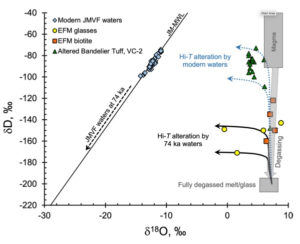Wolff, J.A.; Neukampf, J.
Bulletin of Volcanology, 2022, 84, 99

Voir en ligne : https://doi.org/10.1007/s00445-022-01609-w
Abstract :
The Battleship Rock Ignimbrite of the East Fork Member of the Valles Rhyolite (USA) consists of a variably welded compound cooling unit emplaced in the southern part of the Valles Caldera at 74 ka. At the type locality, the unit was deposited in a narrow paleocanyon and is glassy throughout, with little petrographic evidence for post-eruptive alteration. Biotites from different zones in the ignimbrite at this location, and associated lavas and fallout deposits of the East Fork Member, frequently exhibit low analytical totals (< 94 wt%; by electron microprobe) that are correlated with potassium (K) depletion and enriched in lithium (Li). These variations between samples are systematically related to the welding profile of the ignimbrite. Biotites with low totals are accompanied by groundmass glass with low δ18O, which requires high temperature interaction with meteoric water. The low totals, K depletion, and Li enrichment are therefore attributed to a brief episode of meteoric-hydrothermal alteration of the cooling tuff immediately following emplacement. The duration of the episode is estimated to be on the order of months or less, constrained by Cs, Rb, and Sr mobility in glass. Additional variations in glass and biotite chemistry are identified as primary, and offer an avenue to deciphering the complex event stratigraphy of the eruption, with implications for hazard potential of future rhyolitic eruptions from Valles Caldera.



